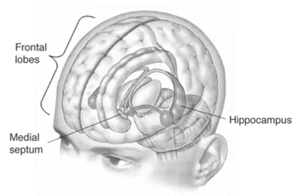亨利·莫莱森
| 亨利·古斯塔夫·莫莱森 Henry Gustav Molaison | |
|---|---|
| 出生 | 1926年2月26日 |
| 逝世 | 2008年12月2日(82岁) |
亨利·古斯塔夫·莫莱森(英语:Henry Gustav Molaison,1926年2月26日—2008年12月2日),在医学界以 H.M.知名。他是一位美国籍的记忆障碍患者,原因是因为他曾罹患严重的癫痫症。当时为了治好他的症状,威廉·B·斯科维尔医生对他施行了双内侧前颞叶切除术,移除了他大脑中三分之二的海马体 、海马旁回、内嗅皮层、梨状皮质,以及杏仁核。他自1957年后,开始接受学界对他广泛的研究,直至于2008年逝世为止。[1][2] 他的案例对于大脑在学习记忆功能,以及认知神经心理学(心理学的分支之一,旨在了解大脑的结构和功能,及其与心理学上的关联)的学术研究方面,占有非常重要的角色。 他住在温莎洛克斯镇的一所看护中心,并在那里作为被研究调查的对象。[3]
2009年12月4日,莫莱森的大脑被保存在加利福尼亚大学圣地亚哥分校[4],研究者可在该校找到相关的资料[5],另一个在死后得到同等待遇的人是爱因斯坦[6]。
生平
[编辑]
莫莱森生于1926年2月26日,7岁时因为一次自行车事故而得了顽固型癫痫。(对于此事故,早期的报导指是于9岁时发生,后来在患者母亲的指正下改为7岁[7])。此后,他就为局部发作癫痫所苦;16岁生日后,又发生了几次僵直性癫痫。1953年,他开始接受哈特福医院神经外科一位名叫威廉·B·斯科维尔(William Beecher Scoville)医生的治疗。[2]
史可维尔医生认为,莫莱森的癫痫与左右脑的“内侧中央颞叶”(medial temporal lobes,MTLS)有关,故建议切除MTLS。1953年8月25日,27岁的莫莱森接受了双内侧前颞叶切除术,他的海马构造与邻近组织,大部分的杏仁核与内鼻皮层也被切除。此后,他的海马体完全无功能,因为剩余约2厘米的海马组织已萎缩,且负责传递感觉给海马体的内鼻皮层也被损毁,而他的部分外侧颞叶也被破坏。
此次手术,虽然成功的控制了莫莱森的癫痫症状,但却带来了严重的痛苦-顺行性遗忘症。尽管他的工作记忆与程序记忆是完好的,但他无法运用他的外显记忆记住新事物。根据部分科学家的研究,莫莱森学习新语义知识的能力受到损害[8] ,但研究人员对损害的程度有争议。他也有一定程度的逆行性失忆症障碍,不能记得手术前一至二年前的大部分,与11年前的部分事物,这表示他的失忆症是属于短期渐进型 (temporally graded);然而,他的长期程序记忆能力是完好的,因此他可以学习例如新的动作技能,尽管莫莱森不会记得他曾经学过。
这个案例,是由史可维尔医生与布伦达·米尔纳(Brenda Milner)在1957年的研究报告中首次提出的[9] 。在莫莱森的晚年,他不断地填写填字游戏[10],他能借由1953年以前学到的知识中得到线索来填写答案;对于1953年以后的资讯,他能修正他的旧记忆与新记忆,例如他曾修正自己对于乔纳斯·索尔克发明小儿麻痹疫苗的记忆[1]。
他于2008年12月2日过世[2]。
参阅
[编辑]参考文献
[编辑]- ^ 1.0 1.1 Benedict Carey. No Memory, but He Filled In the Blanks. New York Times. December 6, 2010 [2008-12-05]. (原始内容存档于2018-06-13).
Henry Gustav Molaison — known through most of his life only as H.M., to protect his privacy — became the most studied patient in the history of brain science after 1953, when an experimental brain operation left him, at age 27, unable to form new declarative memories. ... After repeated trials on the same puzzles, the man who lost his memory learned to fill in the right answers. 'We found that he could learn new semantic, factual information as long as he had something in his memory to anchor it to,' Dr. Skotko said.
- ^ 2.0 2.1 2.2 Benedict Carey. H. M., an Unforgettable Amnesiac, Dies at 82. New York Times. December 4, 2008 [2008-12-05]. (原始内容存档于2018-06-13).
In 1953, he underwent an experimental brain operation in Hartford to correct a seizure disorder, only to emerge from it fundamentally and irreparably changed. He developed a syndrome neurologists call profound amnesia. He had lost the ability to form new declarative memories.
- ^ Schaffhausen, Joanna. Henry Right Now. The Day His World Stood Still. BrainConnection.com. [2008-08-05]. (原始内容存档于2008-02-09).
- ^ Arielle Levin Becker. Researchers To Study Pieces Of Unique Brain. The Hartford Courant. November 29, 2009 [2015-05-18]. (原始内容存档于2010-01-06).
- ^ Scientists Digitize Psychology’s Most Famous Brain (页面存档备份,存于互联网档案馆), Wired.com
- ^ 新京报. 目擊!切開最珍貴大腦 網絡直播40萬人觀看. 人民网. 新京报. 2009-12-14 [2015-05-18]. (原始内容存档于2018-09-30).
- ^ Corkin, Suzanne. Lasting consequences of bilateral medial temporal lobectomy: Clinical course and experimental findings in H.M.. Seminars in Neurology (New York, NY: Thieme-Stratton Inc.). 1984, 4 (4): 249–259. doi:10.1055/s-2008-1041556.
- ^ Schmolck, Kensinger, Corkin, & Squire, 2002
- ^ William Beecher Scoville and Brenda Milner. Loss of recent memory after bilateral hippocampal lesions. Journal of Neurology, Neurosurgery and Psychiatry. 1957, 20 (1): 11–21. PMC 497229
 . PMID 13406589. doi:10.1136/jnnp.20.1.11.
. PMID 13406589. doi:10.1136/jnnp.20.1.11.
- ^ The Man Who Couldn't Remember. NOVA scienceNOW. June 1, 2009 [2010-12-09]. (原始内容存档于2018-10-05).
In between it all he did puzzles, books upon books of them, a habit he’d picked up as a teenager. Near the end of his life he kept a crossword book and pen with him always, in a basket attached to his walker.
